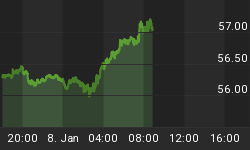In this Observation, we are going to use the Reuters/CRB Futures Index (CRB) as our proxy for commodity prices. We will point out what might be a repeating price pattern.
We began our analysis with a simple 20% swing line chart of our daily CRB price data back to 1956. Upon examination of that chart, we were struck with the similarities of the price patterns of the CRB in the late 1970's/early 1980's and the current pattern that has been unfolding since 1999. We ran the chart past our good friend Don, and he suggested going back one more pattern to the late 1960's/early 1970's.
Here is a monthly chart (updated through March 18, 2005) with swings overlaid in orange and labeled with dates and prices of tops and bottoms.

The following chart shows what we feel appears to be three repeating patterns. Each pattern is color coded orange teal or black and numbered 1, 2 3 and 4.

The statistics for the three patterns is shown in the following table:

Discussion Notes:
-
Each pattern starts with a 1, 2, 3 up/down "set-up" followed by a strong thrust from 3 to 4.
-
The orange cycle "set-up" was the beginning stages of the 1970's inflation.
-
The orange cycle thrust from 3 to 4 includes the first oil price shock in late 1973 when monthly average oil prices rose from $4.31 in December 1973 to $10.11 in January 1974.
-
Other notable moves during the orange cycle: Corn - $1.03 in November, 1971 to $3.97 in September, 1974; Soybeans - $2.33 in October, 1969 to $12.29 in June, 1973; Wheat - $1.13 in September, 1968 to $6.92 in February, 1974; London Metal Exchange Copper - $982.52 in November, 1971 to $3,354.40 in April, 1974; Gold - $34.75 in January, 1970 to $195.25 in December, 1974.
-
The teal cycle "set-up" label 1 marks the bottom of the November, 1973 to March, 1975 recession.
-
The teal cycle thrust from 3 to 4 includes the second oil price shock. Oil prices advanced from a monthly average of $13.90 in July, 1977 to $39.50 in July, 1980.
-
Other notable moves during the teal cycle: Corn - $1.72 in August, 1977 to $3.69 in November, 1980; Soybeans - $4.37 in January, 1976 to $10.46 in April, 1977; Wheat - $2.01 in August, 1977 to $5.07 in November, 1980; London Metal Exchange Copper - $1,124.11 in August, 1977 to 3,168.96 in February, 1980; Gold - $103.50 in August, 1976 to $850.00 in January, 1980; Silver - $3.82 in January, 1976 to $48.00 in January, 1980.
-
The black cycle "set-up" label 3 of October, 2001 marks the successful retest of the CRB price of label 1 in July, 1999. The recession bottomed the following month (November 2001).
-
Oil prices bottomed in November, 2001 at $17.43 and have more than tripled since.
-
Other notable moves during the black cycle: Corn - $1.45 in August, 2000 to $3.15 in April, 2004, 1980; Soybeans - $3.99 in October, 2001 to $10.41 in March, 2004; Wheat - $1.94 in August, 2000 to $4.50 in November, 2003; London Metal Exchange Copper - $1,319 in November, 2001 to $3,434.50 in March, 2005; Gold - $255.95 in April, 2001 to $454.20.00 in December, 2004.
-
Measuring each cycle in months from the beginning month of label 1 to the ending month of label 4, we have the following: Orange cycle - 66 months; Teal Cycle - 68 months; Black Cycle - 68 months (through March, 2005).
Final Comments:
-
Three price patterns of the CRB since 1968 appear to be very similar in terms of "set-up" and time duration.
-
We are currently in the third of such patterns.
-
The bulls will note that our Orange Cycle and Teal Cycle were back-to back with a one year pause. A repeat of the pattern after a pause would take commodity prices substantially higher.
-
The bears will suggest that the Black Cycle is almost a carbon copy of the Teal Cycle and a repeat of the price action in the 1980's is in store.
















